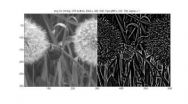Based on a new report called America's Phytonutrient Report: Women's Health by Color, older women have total carotenoid intakes 20 percent greater than younger women after accounting for differences in caloric intake. Similar to the original America's Phytonutrient Report: Quantifying the Gap which found that on average eight out of 10 American adults are falling short on phytonutrient consumption, the new report revealed a troubling shortfall, this time among women and carotenoids. America's Phytonutrient Reports are released by The Nutrilite Health Institute, a worldwide collaboration of experts who are dedicated to helping people achieve optimal health – through research, education, and practical, personalized solutions. Nutrilite is the world's leading brand of vitamin, mineral, and dietary supplements, based on 2008 sales.
Carotenoids are compounds that give fruits and vegetables their vibrant colors, which research suggests may offer breast, ovarian and other health benefits for women. Using NHANES energy-adjusted data to compare the diets of women 45 years and older with those younger, the report finds that many women of all ages lack carotenoid-rich foods in their diet, but the relative magnitude of the "carotenoid gap" is greater among women less than 45 years old as compared to older women.
"This points to a troubling phenomenon where younger women may be missing some of the benefits of consuming more carotenoid rich fruits and vegetables, and yet calorie for calorie, older women are eating more of these important nutrients," said Keith Randolph, Ph.D., Technology Strategist for Nutrilite.
The Carotenoids by Color Category
This new report examined consumption of five different carotenoids across three phytonutrient color categories including alpha-carotene, beta-carotene and beta-cryptoxanthin in the yellow/orange category, lutein/zeaxanthin in the green category and lycopene in red. In every color category, older women consumed equal or greater amounts compared to younger women after adjusting for differences in caloric intake. Specifically, women age 45 and older consume: 50 percent more beta-carotene; 40 percent more alpha-carotene and lutein/zeaxanthin; and, 10 percent more beta-cryptoxanthin.
For lycopene, younger and older women consume comparable amounts.
Carotenoids Shown To Reduce Cancer Risk
A growing body of research suggests carotenoids may be associated with protective benefits against certain cancers. The research points to an apparent lowered risk for breast and ovarian cancers among women of all ages who increase their intake of fruits and vegetables rich in various carotenoids including lutein/zeaxanthin, lycopene, alpha-carotene, beta-carotene and beta-cryptoxanthin according to Randolph.
Top Food Sources
It turns out that a limited number of foods account for significant portions of carotenoid intakes, according to the new report. Following are the single largest food contributors in the diets of American women by color category of phytonutrient:
Green Carotenoid: Lutein/Zeaxanthin
Spinach accounts for 33% of lutein/zeaxanthin intake among younger women and 31% among older.
Red Carotenoid: Lycopene
Tomatoes (and tomato products) account for 93% of lycopene intake among younger women and 89% among older.
Yellow/Orange Carotenoid: Alpha-carotene
Carrots account for 76% of alpha-carotene intake among younger women and 73% among older.
Yellow/Orange Carotenoid: Beta-carotene
Carrots account for 33% of beta-carotene intake among younger women and 30% among older.
Yellow/Orange Carotenoid: Beta-cryptoxanthin
Oranges (and orange juice) account for 61% of beta-cryptoxanthin intake among younger women and 60% among older.
Powering Up Produce
Choosing to increase the amount of the fruit and vegetables richest in carotenoids is important for long-term preventative health among women. While foods like spinach, tomatoes and carrots are certainly part of a healthy diet, there are opportunities for women to choose a wider variety of produce. For example, while carrots are among the top food sources of alpha and beta-carotenes, cooked pumpkin is also a concentrated food source of not only those carotenes, but of beta-cryptoxanthin. However, based on the current data analysis, cooked pumpkin accounts for less than 3% of total intake of these carotenoids among American women.
"It's concerning that so many American women lack a variety of carotenoid-rich foods in their regular diets," says Amy Hendel, Nutrilite's Phytonutrient Coach. "By selecting the most carotenoid-rich produce choices, women can purposefully increase their carotenoid and phytonutrient intakes which can impact health significantly as they age."
Hendel, a registered physician assistant and health/wellness expert, offers these easy substitutions to "power up" your plate and add new flavors to your meal plan:
Green: A serving of cooked kale provides triple the amount of lutein/zeaxanthin as a serving of raw spinach.
Red: A serving of guava delivers more than one and a half times the lycopene in a raw tomato.
Yellow/Orange:
A serving of sweet potatoes has nearly double the beta-carotene as a serving of carrots.
A serving of carrots delivers four times the amount of alpha-carotene as a serving of winter squash.
A serving of fresh papaya has roughly 10 times the beta-cryptoxanthin found in an orange.
Hendel adds, a good goal for most individuals is to consume 10 servings of fruits and vegetables daily, with an emphasis on quality, not just quantity. If this proves challenging, consider a natural, plant-based dietary supplement which includes phytonutrients such as carotenoids.
"Just remember, small changes in the diet each day can add up to powerful changes over time. Older women may eat more carotenoids, but women of all ages are falling short. Diet is a lifetime of exposure and best we teach younger women how to eat right, up those carotenoids, and exercise more from the beginning," says Hendel.
INFORMATION:
To see whether they have a "phytonutrient gap," women can check out the Daily Phytonutrient Snapshot at www.nutrilite.com/color. Women will also find helpful online tools like the Phytonutrient Spectrum which brings to life the colors, health benefits and fruits and vegetables associated with select phytonutrients, including the carotenoids.
For further information about the health benefits of phytonutrients, the America's Phytonutrient Report series, and more practical tips visit www.nutrilite.com/color.
(1) State-Specific Trends in Fruit and Vegetable Consumption Among Adults – United States, 2000-2009. Centers for Disease Control and Prevention, MMWR, Volume 59, No 35.
About Nutrilite
Nutrilite is the world's leading brand of vitamin, mineral, and dietary supplements, based on 2008 sales. Nutrilite (www.nutrilite.com) is so committed to total quality control of its plant concentrates from seed to tablet, it's the only global vitamin and mineral brand to grow, harvest, and process plants on its own certified organic farms, located in California, Washington, Mexico, and Brazil. Nutrilite products are available exclusively through Amway Global Independent Business Owners (IBOs) in North America.
About America's Phytonutrient Report: Women's Health by Color
America's Phytonutrient Report: Women's Health by Color was based on analyses conducted by Exponent for Nutrilite Health Institute. The analyses were developed from dietary recall and health examination data from NHANES, surveys designed to assess the health and nutritional status of the U.S. population, and supplemental nutrient concentration data from the United States Department of Agriculture (USDA) and the published literature. The analyses were completed by Exponent for Nutrilite in July 2010.

